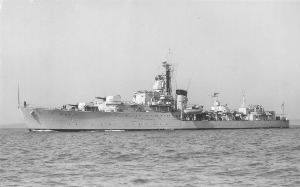Name HMS Agincourt Yard number 664 Completed 25 June 1947 Construction started 12 December 1943 Length 116 m | Ordered 1943 Laid down 12 December 1943 Commissioned 25 June 1947 Launched 29 January 1945 | |
 | ||
Builder Hawthorn Leslie and Company | ||
HMS Agincourt (D86) was a later or 1943 Battle-class fleet destroyer of the Royal Navy. She was named in honour of the Battle of Agincourt, fought in 1415 during the Hundred Years' War. Agincourt was built by R. & W. Hawthorn, Leslie & Company Limited on the River Tyne. She was launched on 29 January 1945 and commissioned on 25 June 1947.
Contents
Service
She joined the 4th Destroyer Flotilla, part of the Home Fleet based in the UK. In 1951, Agincourt subsequently became Captain (D), meaning she was the leader of the flotilla. In 1953 she took part in the Fleet Review to celebrate the Coronation of Queen Elizabeth II. In the following year Agincourt, along with the rest of the squadron, formerly flotilla, deployed to the Mediterranean. The squadron and Agincourt did not return home until the following year. In 1956 Agincourt she formed part of the Royal Navy force which took part in the Suez Crisis. In 1957, Agincourt, and the 4th Destroyer Squadron, returned to the Mediterranean.
Refit and conversion to Radar Picket
In 1959, Agincourt and three of her sister-ships underwent conversion to become radar pickets. The conversion included the addition of the Sea Cat missile and new radar, as well as newer Anti-Aircraft weaponry. In 1962, Agincourt returned to active duty and saw service in the Home and Mediterranean Fleets with a variety of squadrons. In 1966, Agincourt was reduced to Operational Reserve, and was subsequently placed on the disposal list in 1972. She was broken up in Sunderland in 1974.
